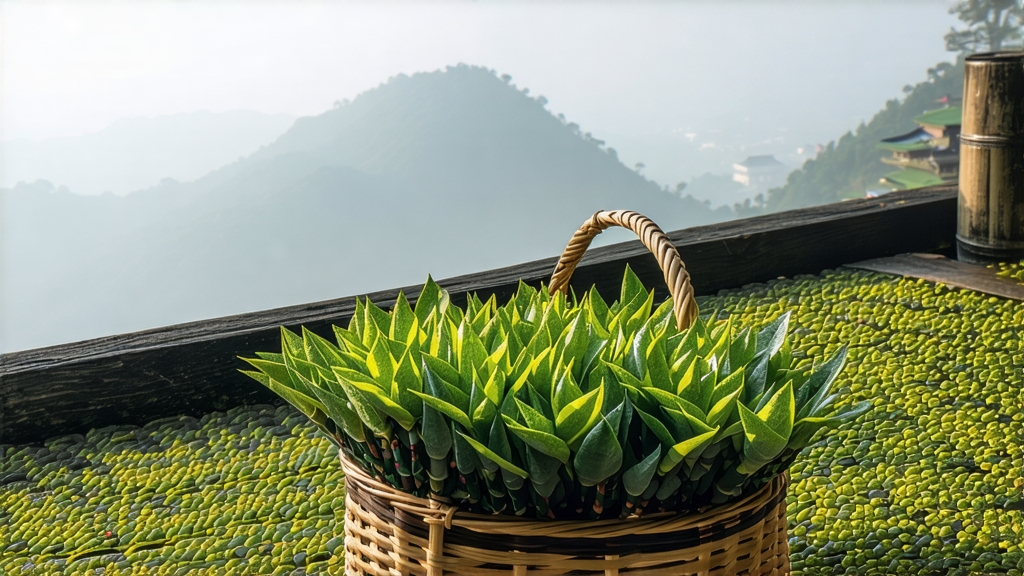
Meng Ding Huang Ya, literally “Yellow Bud from Meng Summit,” is the least exported yet most aristocratic member of China’s yellow-tea family. For thirteen centuries its tiny spring buds were carried by horse and palanquin to the Tang, Song and Ming courts, crossing the perilous plank roads that link Sichuan’s inland basin to the ancient capitals of Chang’an and Luoyang. Today the same narrow ridge—Meng Ding, the “Peak of the Hazy Curtain”—still rises 1 456 m above the fertile Chengdu Plain, trapping humid clouds between the Min River and the Tibetan Plateau. Those clouds act like a natural yellowing chamber long before the tea maker even touches the leaf, saturating the buds with moisture and amino acids that later translate into the famous “mellow yellow” cup.
History first mentions the tea in 724 CE when the monk Wu Li-zhen planted seven tea bushes on the summit as an offering to the mountain spirit. Tang dynasty tribute records list “Meng Shan Stone Flower” alongside silk and spices; by the Song era the name had shifted to “Yellow Bud,” a term that distinguished the pale, straw-coloured dry leaf from the greener “Stone Flower” picked later in spring. After the fall of imperial tribute in 1911 the craft almost vanished: Republican-era merchants preferred easy-selling green tea, and the subtle sealed-yellowing technique survived only in the memory of three hereditary families in the village of Ganxi. A state-led revival in 1959 brought the tea back to market, yet annual production still hovers below fifteen tonnes, most of it pre-sold to collectors in Chengdu and Beijing.
The cultivar behind the tea is a local Sichuan shrub variety called “Meng Ding Xiao Ye Zhong,” small-leaf, slow-growing, and frost-resistant. Only the unopened bud or, in the finest “Bud Needle” grade, the bud plus half-open first leaf are plucked during the fifteen-day window that opens when daily temperatures stabilize between 12 °C and 18 °C. A skilled picker can gather barely 300 g in a dawn shift; 60 000 buds are required for one kilogram of finished tea.
What follows is a choreography of heat, moisture and patience known as “sealed yellowing,” the step that lifts Meng Ding Huang Ya out of the green-tea realm. First the buds are pan-fired in bamboo-ribbed woks at 160 °C for four minutes, a de-enzyming shock that locks in the jade-green colour yet leaves 8–10 % residual moisture. While still warm the leaf is wrapped in thick cotton cloth and placed inside a bamboo steamer; the bundle is then buried overnight in a chest of fresh chestnut charcoal ash. The ash radiates a gentle 38 °C, creating a humid, oxygen-poor microclimate. Over the next 48 hours the cloth is opened every six hours to aerate and re-wrap; chlorophyll breaks down, polyphenols oxidise slightly, and a golden pigment called pheophytin emerges. The leaf edges turn ochre, the centre remains jade, giving the tea its signature “two-tone” look. Finally the buds are slow-dried for three hours over charcoal whose temperature drops gradually from 80 °C to 50 °C, fixing the yellow hue and developing a chestnut-sweet aroma.
The finished leaf is slim and slightly curved, the colour of antique parchment shot through with green lightning. Aroma from the dry jar is discreet: steamed maize, fresh lychee peel, a trace of Sichuan pepper orchards that lie further down the slope. Once brewed the buds stand upright in the glass like a miniature bamboo forest, then slowly sink, releasing a liquor the colour of late-harvest Riesling.
Water is the first variable a foreign brewer must respect. Because the leaf is so tender, high mineral content will dull its orchid sweetness; reverse-osmosis or alpine spring water with TDS below 80 ppm is ideal. Heat to 85 °C, just when the kettle begins to whisper, not shout. Measure 3 g of buds for every 120 ml of vessel; a tall glass or a 150 ml gaiwan allows the vertical dance to be observed. Awaken the leaf with a 15-second rinse, discard, then infuse 45 seconds. Subsequent steeps lengthen by ten seconds; the tea will yield five aromatic brews before fading.